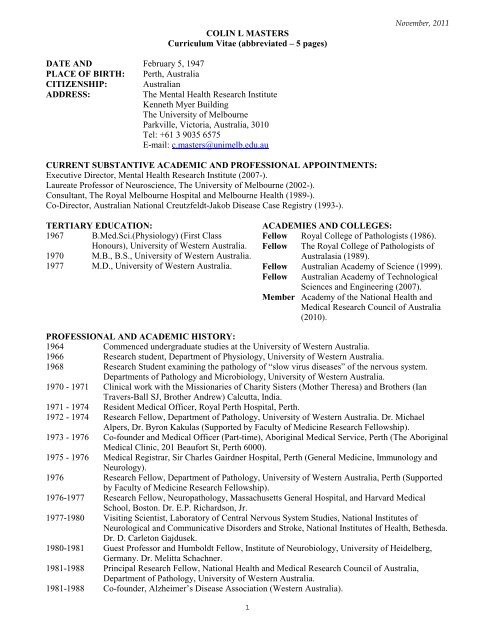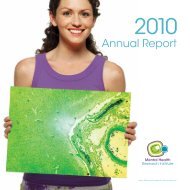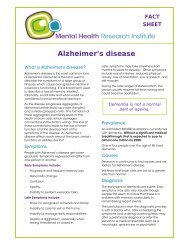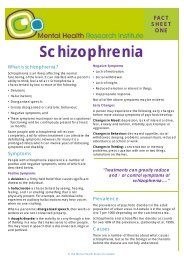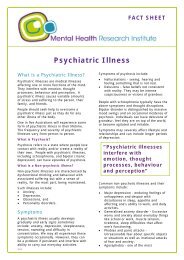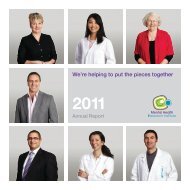Laureate Professor Colin L. Masters CV - Mental Health Research ...
Laureate Professor Colin L. Masters CV - Mental Health Research ...
Laureate Professor Colin L. Masters CV - Mental Health Research ...
Create successful ePaper yourself
Turn your PDF publications into a flip-book with our unique Google optimized e-Paper software.
COLIN L MASTERS<br />
Curriculum Vitae (abbreviated – 5 pages)<br />
November, 2011<br />
DATE AND February 5, 1947<br />
PLACE OF BIRTH: Perth, Australia<br />
CITIZENSHIP: Australian<br />
ADDRESS:<br />
The <strong>Mental</strong> <strong>Health</strong> <strong>Research</strong> Institute<br />
Kenneth Myer Building<br />
The University of Melbourne<br />
Parkville, Victoria, Australia, 3010<br />
Tel: +61 3 9035 6575<br />
E-mail: c.masters@unimelb.edu.au<br />
CURRENT SUBSTANTIVE ACADEMIC AND PROFESSIONAL APPOINTMENTS:<br />
Executive Director, <strong>Mental</strong> <strong>Health</strong> <strong>Research</strong> Institute (2007-).<br />
<strong>Laureate</strong> <strong>Professor</strong> of Neuroscience, The University of Melbourne (2002-).<br />
Consultant, The Royal Melbourne Hospital and Melbourne <strong>Health</strong> (1989-).<br />
Co-Director, Australian National Creutzfeldt-Jakob Disease Case Registry (1993-).<br />
TERTIARY EDUCATION:<br />
1967 B.Med.Sci.(Physiology) (First Class<br />
Honours), University of Western Australia.<br />
1970 M.B., B.S., University of Western Australia.<br />
1977 M.D., University of Western Australia.<br />
ACADEMIES AND COLLEGES:<br />
Fellow Royal College of Pathologists (1986).<br />
Fellow The Royal College of Pathologists of<br />
Australasia (1989).<br />
Fellow Australian Academy of Science (1999).<br />
Fellow Australian Academy of Technological<br />
Sciences and Engineering (2007).<br />
Member Academy of the National <strong>Health</strong> and<br />
Medical <strong>Research</strong> Council of Australia<br />
(2010).<br />
PROFESSIONAL AND ACADEMIC HISTORY:<br />
1964 Commenced undergraduate studies at the University of Western Australia.<br />
1966 <strong>Research</strong> student, Department of Physiology, University of Western Australia.<br />
1968 <strong>Research</strong> Student examining the pathology of “slow virus diseases” of the nervous system.<br />
Departments of Pathology and Microbiology, University of Western Australia.<br />
1970 - 1971 Clinical work with the Missionaries of Charity Sisters (Mother Theresa) and Brothers (Ian<br />
Travers-Ball SJ, Brother Andrew) Calcutta, India.<br />
1971 - 1974 Resident Medical Officer, Royal Perth Hospital, Perth.<br />
1972 - 1974 <strong>Research</strong> Fellow, Department of Pathology, University of Western Australia. Dr. Michael<br />
Alpers, Dr. Byron Kakulas (Supported by Faculty of Medicine <strong>Research</strong> Fellowship).<br />
1973 - 1976 Co-founder and Medical Officer (Part-time), Aboriginal Medical Service, Perth (The Aboriginal<br />
Medical Clinic, 201 Beaufort St, Perth 6000).<br />
1975 - 1976 Medical Registrar, Sir Charles Gairdner Hospital, Perth (General Medicine, Immunology and<br />
Neurology).<br />
1976 <strong>Research</strong> Fellow, Department of Pathology, University of Western Australia, Perth (Supported<br />
by Faculty of Medicine <strong>Research</strong> Fellowship).<br />
1976-1977 <strong>Research</strong> Fellow, Neuropathology, Massachusetts General Hospital, and Harvard Medical<br />
School, Boston. Dr. E.P. Richardson, Jr.<br />
1977-1980 Visiting Scientist, Laboratory of Central Nervous System Studies, National Institutes of<br />
Neurological and Communicative Disorders and Stroke, National Institutes of <strong>Health</strong>, Bethesda.<br />
Dr. D. Carleton Gajdusek.<br />
1980-1981 Guest <strong>Professor</strong> and Humboldt Fellow, Institute of Neurobiology, University of Heidelberg,<br />
Germany. Dr. Melitta Schachner.<br />
1981-1988 Principal <strong>Research</strong> Fellow, National <strong>Health</strong> and Medical <strong>Research</strong> Council of Australia,<br />
Department of Pathology, University of Western Australia.<br />
1981-1988 Co-founder, Alzheimer’s Disease Association (Western Australia).<br />
1
November, 2011<br />
1981-1988 Clinical Assistant (<strong>Research</strong>), Department of Neuropathology, Royal Perth Hospital.<br />
1988 Overseas study leave. Center for Molecular Biology, University of Heidelberg. Prof. Konrad<br />
Beyreuther.<br />
1989-2006 <strong>Professor</strong>, and Head of Department of Pathology, The University of Melbourne.<br />
1989-2006 Consultant, Chief of Neuropathology Laboratory, and Chair, Senior Scientists’ Council, <strong>Mental</strong><br />
<strong>Health</strong> <strong>Research</strong> Institute of Victoria.<br />
1989-2006 Consultant, The Royal Melbourne Hospital and Committee Member of the Executive of the<br />
Melbourne <strong>Health</strong> Shared Pathology Services.<br />
1999-2005 Associate Dean (<strong>Research</strong>), Faculty of Medicine, Dentistry and <strong>Health</strong> Sciences, The University<br />
of Melbourne.<br />
2002- <strong>Laureate</strong> <strong>Professor</strong> of Neuroscience, The University of Melbourne.<br />
2007- Executive Director, <strong>Mental</strong> <strong>Health</strong> <strong>Research</strong> Institute.<br />
2008 - 2009 Chair, Directors Coordination Forum, Melbourne Neuroscience Project.<br />
EDITORIAL BOARDS:<br />
American Journal of Alzheimer’s Disease and Other Dementias (1997 -)<br />
Annals of Neurosciences (2009 -)<br />
Archives of Neurology, International Advisory Committee (1996 -)<br />
Brain Ageing (2002 -)<br />
Brain <strong>Research</strong> (1994 -)<br />
Current Alzheimer <strong>Research</strong> (2003 -)<br />
Dementia and Geriatric Cognitive Disorders (1989 -)<br />
International Journal of Biochemistry and Cell Biology (2006-)<br />
Journal of Alzheimer’s Disease (1997 -)<br />
Journal of Clinical Neuroscience (1994 -)<br />
Journal of Molecular Neurodegeneration (2005-)<br />
Neurodegenerative Diseases (2002 -)<br />
Neuropathology (1997 -)<br />
<strong>Research</strong> and Perspectives in Alzheimer’s Disease (Foundation IPSEN) (1990 -)<br />
Translational Psychiatry (2011 - )<br />
ADVISORY AND EXECUTIVE COMMITTEE MEMBERSHIPS:<br />
Alzheimer’s Disease International. Medical and Scientific Advisory Panel.<br />
Australian Imaging Biomarkers and Lifestyle (AIBL) study, Management Committee<br />
Australian National Creutzfeldt-Jakob Disease Case Registry Co-Director (1993-).<br />
Centre for Neuroscience, Faculty of Medicine, Dentistry and <strong>Health</strong> Sciences, The University of Melbourne.<br />
Management Advisory Board and Member of Executive Committee.<br />
Creutzfeldt-Jakob Disease Registry Advisory Group, Commonwealth Department of <strong>Health</strong> and Aging (Chair)<br />
(2003-).<br />
Dominantly Inherited Alzheimer Network (DIAN), Steering Committee.<br />
Directors Coordination Forum, Melbourne Neuroscience Project (2008-).<br />
Fondation Alliance BioSecure. Scientific Advisory Board (2009-).<br />
Infection Control Steering Committee, Communicable Diseases Network Australia New Zealand (CDNANZ).<br />
International Conference on Alzheimer’s Disease and Related Disorders. International Scientific Advisory<br />
Committee.<br />
International Conference on Alzheimer’s and Parkinson’s Disease. Scientific Advisory Board (2005-).<br />
International Society to Advance Alzheimer <strong>Research</strong> and Treatment (ISTAART) Advisory Council (2009-).<br />
Melbourne Theatre Company, Board Member (2006-).<br />
National <strong>Health</strong> and Medical <strong>Research</strong> Council. Transmissible Spongiform Encephalopathies Advisory Committee<br />
(Deputy Chair 2000-2010), (Chair 2010-2012).<br />
Neuroscience Victoria, member Board of Directors.<br />
Prana Biotechnology. Scientific Advisory Board (2007-).<br />
Van Cleef/ Roet Centre for Nervous Diseases, Monash University. Advisory Board.<br />
World Federation of Neurology <strong>Research</strong> Group on Dementia. Executive Committee.<br />
World Federation of Societies of Biological Psychiatry (WFSBP), Task Force on Dementia (2004-).<br />
2
November, 2011<br />
HONORS, PRIZES, NAMED AND INVITED LECTURES, AND OTHER SPECIAL SCIENTIFIC<br />
RECOGNITION:<br />
1988 Dr. Gunther Buch prize (with Konrad Beyreuther).<br />
Robert Pfleger Prize (with Konrad Beyreuther).<br />
1990 American Academy of Neurology, Potamkin Prize (with Konrad Beyreuther).<br />
1991 Max Planck <strong>Research</strong> Award from the Alexander von Humboldt Foundation (with Konrad<br />
Beyreuther).<br />
1993 Chairman, Foundation IPSEN Meeting on “βA4 Amyloid Protein Precursor in Development, Aging<br />
and Alzheimer’s Disease” (Lyon).<br />
Fellow, Brain-Behaviour <strong>Research</strong> Institute, LaTrobe University.<br />
1995 Convenor, International Workshop on Creutzfeldt-Jakob Disease (Melbourne).<br />
KJ Zülch Prize (with Konrad Beyreuther) from the Gertrud Reemtsma Stiftung of the Max Planck<br />
Society (Cologne).<br />
1996 WHO Consultation on Clinical and Neuropathological Characteristics of the New Variant of<br />
Creutzfeldt-Jakob disease and other human and animal transmissible spongiform Encephalopathies<br />
(Geneva).<br />
1997 King Faisal International Prize in Medicine (with Konrad Beyreuther and James Gusella).<br />
George S Christie Lecture, Australasian Society for Experimental Pathology.<br />
Erna Struckmann Lecture, Centre for Molecular Biology, The University of Heidelberg.<br />
Chairperson, WHO Consultation on Medical and other Products in Relation to Human and Animal<br />
Transmissible Spongiform Encephalopathies (Geneva).<br />
1998 Alois Alzheimer Award (University of Munich).<br />
1999 WHO Consultation on Diagnostic Procedures for Transmissible Spongiform Encephalopathies and<br />
WHO Consultation on Caring for Patients and Hospital Infection Control in Relation to Human<br />
Transmissible Spongiform Encephalopathies (Geneva).<br />
2000 IPSEN Foundation: convenor of Symposium on Neurodegeneration (Paris).<br />
2001 Bethlehem Griffiths <strong>Research</strong> Foundation Medal.<br />
Australian Citation <strong>Laureate</strong> (1981-1998), ISI Thompson Scientific Award.<br />
2002 Mayne Florey Medal Award.<br />
<strong>Laureate</strong> <strong>Professor</strong>, The University of Melbourne.<br />
2003 Halford Oration, The University of Melbourne.<br />
Alzheimer’s Australia WA, Life Membership.<br />
2004 Vernon Plueckhahn Oration, Geelong Hospital.<br />
Boehringer – Ingleheim Lecture (University of Maniz)<br />
Guest Scientist, Biomedical <strong>Research</strong> Council, Singapore<br />
2005 Fulton Symposium Soriano Lecture, World Congress of Neurology (Sydney)<br />
2006 Lennox K. Black Prize (Thomas Jefferson University, Philadelphia).<br />
Lifetime Achievement Award in Alzheimer’s Disease <strong>Research</strong> (Alzheimer’s Association).<br />
Grand Hamdan International Award for Medical Sciences in the field of Molecular and Cellular<br />
Pathology of Neurological Disorders, (Dubai).<br />
Honorary Chief-Elect, Ikoro II of Ogborland, Ogbor Autonomous Community, Ihitteafoukwu,<br />
Ahiazu Mbaisc, Imo State, (Nigeria).<br />
2007 Victoria Prize from the Minister for Innovation, State Government of Victoria and the Smorgon<br />
Foundation<br />
2008 Honorary Doctor of Letters, University of Western Australia.<br />
2009 Leach Lecture and Medal, Lorne Conference on Protein Structure and Function.<br />
2011 CSIRO Medal for <strong>Research</strong> Achievement.<br />
Citation record: h-factor (ISI-Thomson Scientific) at 19 July, 2011 = 87<br />
3
November, 2011<br />
CAREER SUMMARY<br />
<strong>Masters</strong> began his research career as a 1966 summer student working with Evan Morgan (Physiology,<br />
The University of Western Australia) on the placental transfer of plasma proteins. His interests in neuroscience<br />
stem from this time, when he then took the opportunity to pursue a Bachelor of Medical Science degree with<br />
Brian Johnstone and Judith Laszlo, resulting in the first demonstration of brain-stem evoked responses to<br />
auditory stimuli in humans.<br />
Toward the end of 1967, MacFarlane Burnet gave a lecture in Perth on kuru. This, together with the<br />
connections that Byron Kakulas and Michael Alpers (both at the University of Western Australia in Perth) had<br />
established with D. Carleton Gajdusek and Clarence J. Gibbs at the NIH, led to <strong>Masters</strong>’ ongoing study of the<br />
transmissible spongiform encephalopathies (prion diseases). These studies began with the pathologic evaluation<br />
of preclinical disease, and continued with studies on the nature of spongiform change (with E.P. Richardson,<br />
Harvard Medical School). Studies followed on the epidemiology of Creutzfeldt-Jakob disease, the familial<br />
patterns of these diseases, and the identification of a special subgroup (the Gerstmann-Sträussler syndrome<br />
[GSS]) in which abundant amyloid deposition is a hallmark. The delineation of GSS gave an important lead to<br />
the first demonstration by Prusiner and colleagues of a pathogenic mutation in a gene coding for prion protein.<br />
The evaluation of amyloid protein deposition in transmissible prion diseases (subsequently shown by<br />
Prusiner and colleagues to be comprised of the PrP, or prion protein) led <strong>Masters</strong> to begin to study the nature of<br />
the amyloid deposits found in the brain in Alzheimer’s disease (AD) in 1978. Amyloid protein was first purified<br />
from neuritic plaques in 1979, and described in 1983. However, it was not until a collaboration was formed in<br />
1984 between <strong>Masters</strong> and Konrad Beyreuther (then at the Institute of Genetics, Cologne) that the N-terminal<br />
sequence of the Alzheimer plaque amyloid was obtained, at the same time as the N-terminal sequence of<br />
vascular amyloid was determined by George Glenner (with whom <strong>Masters</strong> had also collaborated).<br />
These studies over the period 1978-1988 set the scene for <strong>Masters</strong>’ research directions when he moved<br />
to the University of Melbourne in 1989. There, his research evolved into developing therapeutic strategies based<br />
around the central amyloidogenic pathway in AD. Two principal strands emerged, one attempting the inhibition<br />
of the γ- and β-secretases which release the Aβ peptide from APP, the other deriving from the observations on<br />
an important interaction between metal ions and APP/Aβ.<br />
As the real potential for development of pharmaceuticals that could delay the onset of AD, or slow its<br />
progression, became apparent, <strong>Masters</strong> initiated collaborations with major pharmaceutical companies<br />
SmithKline Beecham and Merck. These first focussed on the identification of the α- and β-secretases, as these<br />
play a key role in the generation of the N-terminus of β-amyloid in the brain, and subsequently on the<br />
development of powerful specific inhibitors of the presenilin complex associated with γ-secretase activity.<br />
Those collaborative studies have been brought to a point where Phase 3 clinical trials are in progress.<br />
<strong>Masters</strong> and colleagues then developed a parallel strategy around studies of the toxic gain-of-function of<br />
Aβ amyloid as it accumulates in the brain, reasoning that compounds directed to interfere with the dominant<br />
negative property of Aβ might provide a different but complementary approach to that utilising secretase<br />
inhibition. This strategy is proving to be of great promise. One mechanism by which Aβ exerts its toxic effect is<br />
through oxidative damage when Aβ amyloid comes into contact with redox active metal ions such as Cu 2+ .<br />
Toxic soluble oligomers of Aβ are now thought to aggregate within and on membranes of neurons. <strong>Masters</strong>’<br />
group has identified compounds that prevent Cu 2+ interacting with Aβ, and have the additional desirable<br />
properties of abrogating the generation of H 2 O 2 and at the same time causing solubilisation of polymerised Aβ.<br />
Such compounds have been tested in experimental models of AD with positive results. Two compounds have<br />
been trialled in Phase 2a studies in humans with mild to moderate AD. If confirmed in larger (Phase 2b/3)<br />
studies, this may become one of the first pharmacological interventions to test the Aβ theory of AD.<br />
With the emergence of variant forms of CJD as a major threat to public health, <strong>Masters</strong> re-established a<br />
research group on prion dementias. He brought the knowledge gained from his AD studies, particularly with<br />
respect to the roles of metal ions, to bear on the problem of PrP toxic gain-of-function. This may also lead to<br />
new approaches to therapy for the prion dementias, for which there are no effective treatments at present. He<br />
has a major commitment to public policy and is an active contributor to Government committees on variant CJD<br />
in both the UK and Australia, helping in efforts to deal with this threat.<br />
In summary, <strong>Masters</strong>’ career has come full circle, from the pathological study of human brain disease to<br />
clinical trials, and from discovery and characterisation of the Aβ aggregation in AD, to the development of a<br />
coherent theory on the mechanisms of Aβ amyloid production and its role in causation of neurodegeneration.<br />
This theory has become the generally accepted paradigm for investigating Alzheimer disease. The single, most<br />
characteristic, feature of <strong>Masters</strong>’ research has been the way in which he has approached gene and protein<br />
4
November, 2011<br />
structure and function for a variety of diseases caused by proteins that aggregate in the adult human brain. He<br />
has used the resulting data to generate a rich variety of discoveries that have had a wide impact in understanding<br />
normal and abnormal brain function in disease and in ageing. In the best traditions of translational research,<br />
<strong>Masters</strong> has continued to identify and develop effective rational therapeutic and diagnostic strategies for disease<br />
modification, perhaps even prevention.<br />
For these discoveries, <strong>Masters</strong> has won many prestigious prizes and awards, including the Potamkin Prize of the<br />
American Academy of Neurology (1990), the Max Planck Award of the von Humboldt Foundation (1991), the<br />
Zülch prize of the Max Planck Society (1995), the Faisal International Prize (1997), the Alzheimer Award from<br />
the University of Munich (1998), the Lennox K Black Prize from Thomas Jefferson University (2006), the<br />
Grand Hamdan International Award (2006), and the Victoria Prize from the Minister for Innovation, State<br />
Government of Victoria and the Smorgon Foundation. In 2008 he was awarded the Honorary Degree of Doctor<br />
of Letters from the University of Western Australia. He is active in the Australian Academy of Science (AAS)<br />
and the Australian Academy of Technological Sciences and Engineering (AATSE), and continues to lecture<br />
widely at undergraduate and postgraduate levels. He has been appointed by the Australian Government as Chair<br />
of the National <strong>Health</strong> Committee, principal committee of the National <strong>Health</strong> and Medical <strong>Research</strong> Council of<br />
Australia.<br />
5


